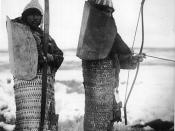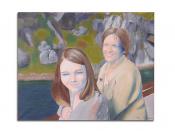The ancient arctic art cannot be understood without deeply understanding the culture of pre-dorset, dorset, norton and the thule peoples. An important turning point in the study of the Eskimo problem was marked by the archaeological excavations of the Thule expedition under Rasmussen, particularly by those of Mathiassen in the Central Eskimo area. It is true that a number of ancient sites had been excavated earlier in the Aleutian Islands1, but the published materials contain few data that throw light on cultural phases and chronological relationships in connection with the problem of the origin of Eskimo culture.
Mathiassen's excavations2 revealed an ancient Eskimo culture to the north of Hudson Bay which Mathiassen called the Thule culture. As Mathiassen pointed out, this culture was found to be not primitive but, on the contrary, developed and specialized, and containing all the most characteristic traits widespread throughout the area occupied by the Eskimos.
This culture was typical for people engaged in hunting sea mammals, particularly whales, who lived predominantly in permanent houses, and who made use of a wide variety of tools of highly elaborate form. The Thule culture is typically arctic art and, at the same time, coastal: it must have originated on a coast abounding in large game, particularly whales. In addition, wood [driftwood] must have been abundant on the coast for the construction of umiaks (since it is either impossible or very difficult to throw a whaling harpoon from a kayak) and of dwellings. Permanent conditions of this kind prevailed only in the west.
In emphasizing the close relationship between the Thule culture and that of the Central Eskimo on the one hand, and that of the Eskimos to the west at Point Barrow, on the other, Mathiassen notes that the connection between them was even closer and more...


